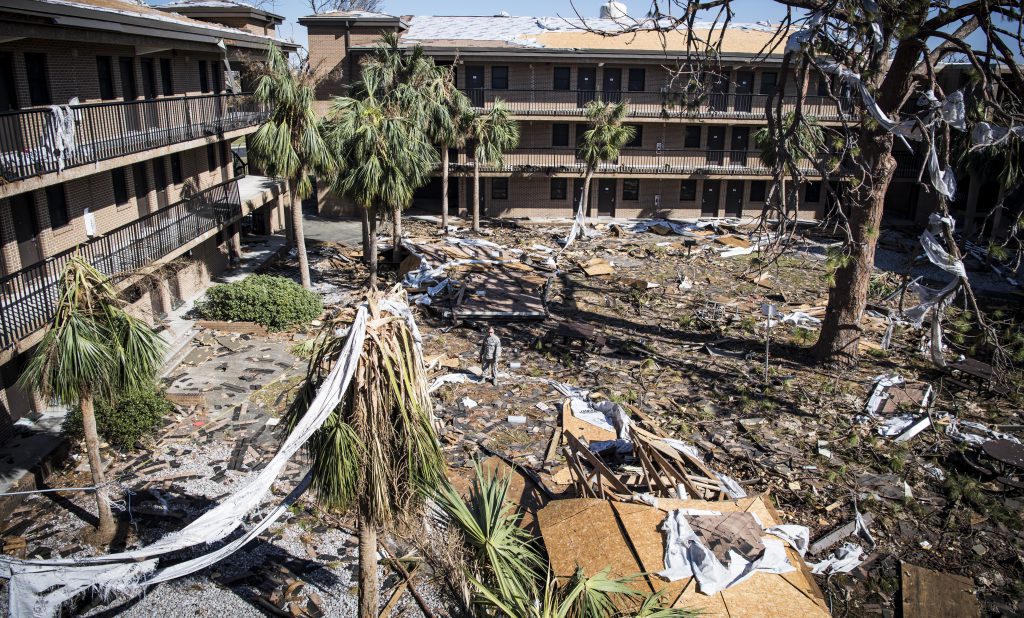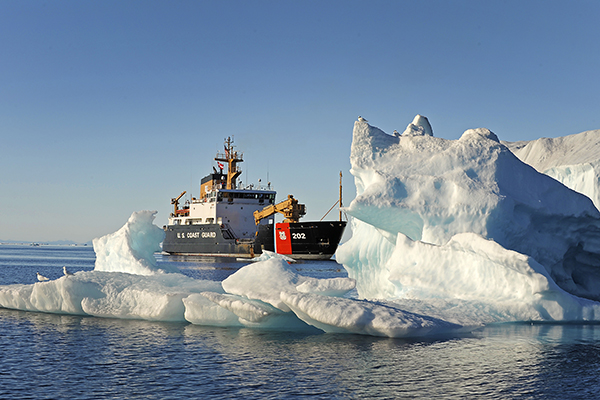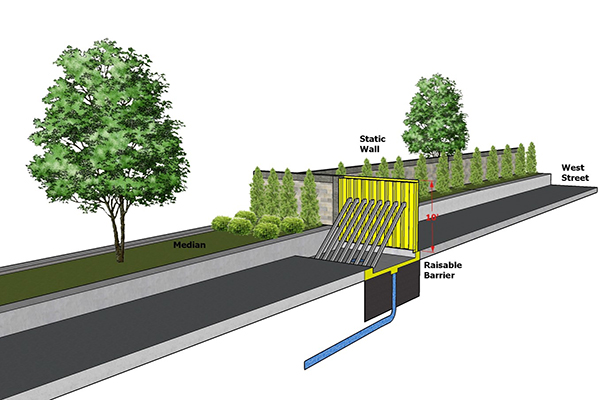By Capt. Kiara Vance, USAF, and Lt. Col. Justin Delorit, Ph.D., P.E., USAF
The federal government’s focus on climate change has increased dramatically since 2017, when a report by the Government Accountability Office indicated that only one-third of surveyed military installations had included climate considerations in infrastructure plans and execution. Subsequent extreme weather events, such as Hurricane Michael’s destruction of Tyndall AFB, Fla., highlighted the urgency for resilient installations that are always ready to support the missions of the Department of Defense (DOD).
Most recently, through the publication of Executive Order 14057, the United States has elected to push for a coordinated whole-of-government approach to achieve climate resilient infrastructure and operations. DOD has made climate risk adaptations associated with infrastructure a priority for asset managers, installation planners, and decision-makers through the adoption of Climate Adaptation Plans, which outline the completion of climate-informed natural resource strategies to better protect installations, while also working with surrounding communities to protect the nearby environment.
An opportunity that has gained popularity to decrease the impact of storm surge is natural infrastructure, such as barrier islands, wetlands, marshes, and oyster reefs. These alternatives to traditional infrastructure enhancements have been found to benefit coastal communities while also providing risk reduction in the form of wave attenuation and surge reduction. Co-benefits to the community include aquatic habitat creation, carbon storage, and recreational uses. Natural alternatives also have the potential to self-recover after an extreme event and can be less expensive to implement than other, traditional options like enlarged storm water systems, seawalls, and breakwaters.
However, implementation guidance and existing policy has lacked among installations most at risk, and natural infrastructure efficacy has only been studied on low intensity hurricanes.

MODELING THREATS
Following the widespread destruction at Tyndall AFB in 2018, a newly formed Program Management Office (PMO) implemented a number of pilot projects in conjunction with DOD’s Readiness & Environmental Protection Integration Program to utilize the existing geography surrounding the base as a protective resource. Sand trapping and sediment placement are two of the strategies that Tyndall is exploring in order to encourage stronger resilience against storm surge. However, performance of the barrier islands that provide natural wave attenuation has not been modeled to determine efficacy as a protective solution to intensified climate projections and higher category storms.
To determine the risk reduction of the strategy at a higher intensity level, a simulated threat analysis was performed using Hazus, an open-source damage estimation software created by the Federal Emergency Management Agency. The study modeled hurricane risk to Tyndall’s facilities by characterizing likely future extreme storms from intensified factors of wind speed, sea level rise, and mean sea level. To determine the value of natural infrastructure as an adaptation alternative, intensified, scenario-based simulations of hurricane-driven surge were run for cases where maintenance of existing island profiles currently exist and are not currently supported by dredging. Facility damage estimates were generated from Hazus at the census-tract level. Given underlying inaccuracy in accounting for exact plant replacement values for Tyndall’s facilities on open-source software, this study used the ratio of damages from maintained and unmaintained islands to create a damage escalation factor. Modeled damages were compared against a no-action alternative.
Maintenance of the barrier islands provides clear loss avoidance in the form of reduced damages across all intensified scenarios. In the most intense end-of-century simulation, maintenance of the barrier islands reduced projected flood damage by three orders of magnitude. Investments at any point in time and intensification scenarios provide reduced damages and option value to decision-makers. Option value is defined as the comparison of high damage-to-implementation cost ratio and the time-value the maintenance regime affords leadership to wait and see which pathway sea-level rise and climate-intensified events take.
Due to the regional nature of island formation, defense locations with similar structures could utilize this analysis as a benchmark, particularly those in the Gulf Coast.
CHALLENGES TO ENACTMENT
The very nature of “natural infrastructure” necessitates collaboration between communities. Maintenance and encouragement of these structures requires expertise and long-term guidance that local installation stakeholders may not be able to provide. The input of multiple parties for coastal management and historical challenges between government organizations adds to a challenging investment environment.
In Florida alone, there is a network of nine agencies and five districts to manage and enforce statues and regulate coastal management fund availability through project competitions. A more centralized strategy to federal funding allocation between military installations and coastal management organizations is necessary to further advance natural conservation and protection efforts toward coastal community resiliency. This approach could be achieved by the designation of a military team to coordinate and execute coastal actions on installations, allowing for integration within the coastal management agencies such as the Office for Coastal Management that are already poised to enact and execute proactive natural infrastructure projects.
Additional implementation roadblocks typically appear in the planning and programming process, where centralized funding takes projects through an order of precedence, and the non-immediacy of climate change negatively impacts efforts. Coastal management efforts characteristically fall under environmental management system jurisdiction rather than infrastructure sustainment, which limits investment instruction. If marine infrastructure systems were redesignated into sustainment packages, co-funding opportunities could increase at the lowest level.
As an example, funding through the National Oceanic & Atmospheric Administration (NOAA) and the Readiness and Environmental Protection Integration Program is dependent on the contributions of non-federal backing from private investors and outside agencies. Altering requirements for additional federal funding through DOD to compete for NOAA allotments would enable joint efforts with respect to coastal land owned by military installations. This would ultimately impact the surrounding community in a manner that has been previously dictated by security restrictions.
A whole-of-government approach to increase installation robustness could be encouraged as well by tax incentives to invest in natural infrastructure management for local agencies, not unlike current efforts for renewable energy.
FUTURE COMMUNITY BENEFITS
The interconnectedness of barrier islands and other naturally occurring structures provides a demand signal to engage the local communities surrounding military installations.
In 2020, Congress amended the National Defense Authorization Act to allow the Readiness & Environmental Protection Integration Program to participate in projects that protect installations from changing environmental conditions. While publishing executive orders and expanding congressional authorization for these project types is beneficial, it does not provide a clear implementation pathway or timeline to base-level stakeholders.
Forecast uncertainty requires that any adaptation decision for coastal installations be approached with caution. Furthermore, assessment of performance metrics and the success of these programs and technologies are yet to be determined outside of initial projections. Additional evaluation alongside competing objectives is required.
Despite growing acceptance of their beneficial attributes, natural infrastructure options may find funding tough to secure due to already increasing existing sustainment requirements for aging installations. Traditional infrastructure solutions have the benefit of a greater available body of knowledge; but the advantage to natural infrastructure implementations lies in the postponement of options that are potentially over-prescriptive, damaging, and cost prohibitive.
Through intentional federal engagement and incentivization, coastal management solutions could be the answer for an optimally timed, appropriate investment to increase robustness for coastal communities in the face of climate change without negatively impacting local environments and surrounding communities.
Capt. Kiara Vance, USAF, is Civil Engineer Air Advisor, and Lt. Col. Justin Delorit, Ph.D., P.E., USAF, is Program Chair and Assistant Professor of Engineering Management, Air Force Institute of Technology. They can be reached at vance.kiaral@gmail.com; and justin.delorit@afit.edu.
More News from TME
-

The Northernmost Theater: A Crucial Frontier for National Security
With abundant natural resources and a critical geographic positioning, the Arctic continues to rise in importance to America’s strategic interests, requiring an ongoing evolution of military, economic, and diplomatic policy. -

Protecting Military Facilities From Flood Risks
As military installations across the nation face increasing flooding risks driven by climate change, understanding the types of floods, their causes, and available measures to mitigate risk can support better resiliency upgrade projects. -

Gaining Real-Time Water Leak Detection
At Devens Reserve Forces Training Area, advanced water meters are offering real-time monitoring of water systems and automated alerts, increasing the installation’s ability to identify leaks and make timely repairs.